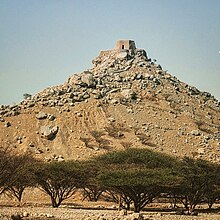Persian Gulf campaign of 1819
After decades of incidents where British shipping had fallen foul of the aggressive Qawasim, an expeditionary force embarked for Ras Al Khaimah in 1809.
Following the incident involving the Surat vessels (said to have been carried out by Amir Ibrahim, a cousin to the Al Qasimi Ruler Hassan Bin Rahmah) an investigation took place and Ariel was despatched to Ras Al Khaimah from Bushire, to where it returned with a flat denial of involvement in the affair from the Qawasim who were also at pains to point out they had not undertaken to recognise 'idolatrous Hindus' as British subjects, let alone anyone from the West Coast of India other than Bombay and Mangalore.
Unsurprisingly, given this ineffective 'punishment', Lorimer reports "The temerity of the pirates increased" and further raids on shipping followed, including the taking of "an Arab vessel but officered by Englishmen and flying English colours" just 70 miles North of Bombay.
[4] After an additional year of recurring incidents, at the end of 1818 Hassan bin Rahmah made conciliatory overtures to Bombay that were "sternly rejected."
Naval resources commanded by the Qawasim during this period were estimated at 60 large boats headquartered in Ras Al Khaimah, carrying from 80 to 300 men each, as well as 40 smaller vessels housed in other nearby ports.
[5] The case made against the Qawasim has been contested by the historian, author and Ruler of Sharjah, Sultan bin Mohammed Al Qasimi in his book The Myth of Arab Piracy in the Gulf, in which he argues that the charges amount to a 'causus belli' by the East India Company, which sought to limit or eliminate the 'informal' Arab trade with India, and presents a number of internal communications between the Bombay Government and its officials, which shed doubt on many of the key charges made by Lorimer in his history of the affair.
[6] At the time, the Chief Secretary of the Government of Bombay, F. Warden, presented a minute which laid blame for the piracy on the Wahhabi influence on the Al Qasimi and the interference of the East India Company in native affairs.
In fact, it was Warden, in his 1819 Historical sketch of the Joasmee Arabs, who stated that up until the close of 1804, the Qawasim committed no act of piracy but, with the exception of the attacks on the Bassein and Viper cruisers, manifested every respect to the British flag.
[7] On 3 November 1819,[8] the British embarked on an expedition against the Qawasim, led by Major-General William Keir Grant, voyaging to Ras Al Khaimah with a force of 3,000 soldiers.
On the fall of Ras Al Khaimah, three cruisers were sent to blockade Rams to the North and this, too was found to be deserted and its inhabitants retired to the 'impregnable' hill-top fort of Dhayah.
There, 398 men and another 400 women and children held out, without sanitation, water or effective cover from the sun, for three days under heavy fire from mortars and 12-pound cannon.
The two 24-pound cannon from HMS Liverpool which had been used to bombard Ras Al Khaimah from the landward side were once again pressed into use and dragged across the plain from the coastal mangrove swamps of Rams, a journey of some three miles.



